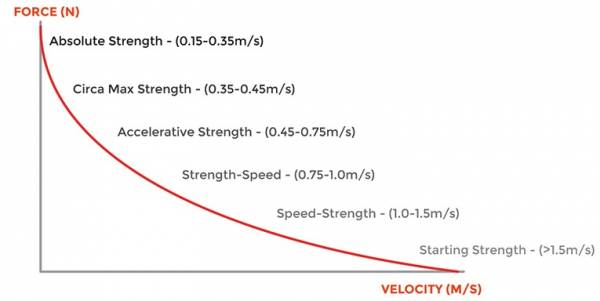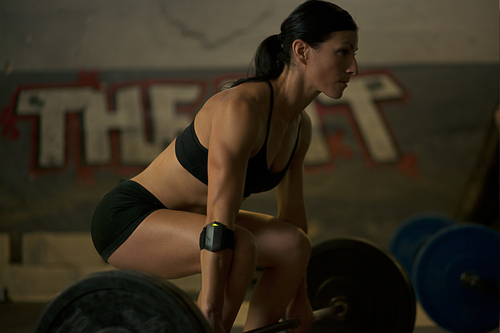How to use velocity based training for strength
This is an overview for how to use velocity based training for the purpose of strength with special focus on the squat, bench press and deadlift. In the article, you will find further links to material on the matter and the several devices which can be used to measure velocity for a barbell.
How can you measure strength ?
How do you train the optimum way each time you are in the gym ? A tricky question coaches and individuals have to work with in a world where time is a precious resource and professional sports is unforgiving. There are many options to choose from to regulate your weekly training for weightlifting. Sets, repetitions, tonnage and more. But which is the best metric to pick when you want to optimize performance for strength ?
This becomes even more complex if you add the dimensions of movement you are interested in when you are playing a team sport which involves some sort of ball. You can measure the body speed, bar speed, and ball speed.
- Body speed relates to how fast athletes can accelerate, change direction, and maximally displace themselves
- Bar speed relates to how fast the barbell moves in the weight room under a certain load
- Ball speed Peak velocity of a known projectile with specific exercises
Which of these do you use as the ultimate indicator of strength and what kind of strength are you interested in ? To make light of the dark you have to choose first what is important for you.
What is velocity ?
"The speed of something in a given direction."
This is the definition of velocity. If you want to use velocity based training you first have to ask yourself what that something is and which purpose it fulfills. When you are a sprinter you will be most interested in body speed so something is replaced with body speed for given definition. For Olympic lifters and powerlifters, the speed of the bar is an interesting indicator for strength and performance. For a quarterback trying to get a pass to a receiver, the speed of the football might be the most interesting piece to measure. So if you want to use velocity based training think hard about what is relevant to your sport. To define what is relevant to you is often the hardest part.
Strength performance is usually measured in terms of how far people can move the same amount of weight (hammer throw, shot put), whether they can move more weight along a very similar distance (squat, bench press, deadlift) or if they can move the same amount of load for the same distance for the most repetitions.
If you want to use velocity based methods for strength purposes know the path of the load you are moving, how much load you use and measure the speed in which that load is moving along the path. As I found that I got the most strength increases when using free weights in the gym let us stick to the squat, bench press and deadlift for this article.
At which velocity do you train for strength ?
 This chart helps you to determine at which velocity or meters per second (m/s you would train to optimize for a certain result. Whatever it is you are moving, this chart can indicate in which area you are. For the purpose of the squat, bench press and deadlift, you would measure how fast in m/s the barbell would travel on each lift and dependent on this decide whether the repetition was performed in the optimum range or not.
This chart helps you to determine at which velocity or meters per second (m/s you would train to optimize for a certain result. Whatever it is you are moving, this chart can indicate in which area you are. For the purpose of the squat, bench press and deadlift, you would measure how fast in m/s the barbell would travel on each lift and dependent on this decide whether the repetition was performed in the optimum range or not.
If you want to train for absolute strength and increase your one repetition maximum you are well advised to train on the upper third of this curve. Most likely you will only perform 1 - 3 repetitions per set when bar speed is that low.
Your main focus is to accelerate and pack a punch in a rugby match ? No problem, stick to the 0.45 to 0.75 m/s range for accelerative strength.
If you want to mainly focus on speed use the lower third of the curve.
How can I measure velocity ?
There are several ways to measure velocity for weight training. It became popular in the early 2000's with the introduction of Tendo into the fitness market. Soon products like Gymaware, Push and Beast followed. There are two main ways to measure velocity:
- Linear position transducers
- Accelerometer based

Linear position transducers work by magnetically or manually attaching a piece of cable to the barbell. Depending on how fast and far you pull the cable during the movement m/s is measured. If you have ever used a concept2 rower in your local gym you have already been using a linear position transducer without even realizing. These devices are generally considered more reliable than accelerometers if the cable action works correctly and you know how to do the movements. The downsides are usually the higher costs of these devices and that they take up more space than the newer wearable alternatives.

Accelerometers can fit into your phone or around your arm. These were made available to the mainstream by the dawn of the wearable technology in which more complex devices can be put into ever smaller spaces. These gizmos measure the relative positioning of the device to its surroundings and from there calculate how fast you are moving, whether you are moving up or down a hill or have fallen down. Applied to weightlifting the resulting product which measures velocity is a lot less clunky than a linear position transducer as there is no need for a cable. The challenge with this approach is the software which interprets the data and also that you have less room for error in case you are not doing the exercise correctly.
Why use velocity based training for strength ?
Repetitions, sets, tonnage and other ways of regulating the intensity of your training like the prilepin's table have one big disadvantage. They do not give you direct feedback when you are doing your session to adjust the load accordingly when you are over- or undertraining. By knowing in which area to train and measuring it on a constant basis including real time feedback you can make sure that you always train at your best.
Conclusion
To make use of velocity based training for strength work in a range of 0.45 to 0.75 m/s for the load you want to move across a specific path. You can measure the velocity by using a linear position transducer or accelerometer. The outcome usually is speedier progression for your goal with lower injury risk based on the direct feedback in correlation with your fitness on the day (good days --> push harder, bad days ---> take it down a notch). Remember that strength does not necessarily equal speed. There are more factors in play than only raw strength when you want improved performance of your athletes or yourself. Velocity based training is costly and time-consuming. Only use it when easier ways of progressing have been explored and exhausted. Avoid the complex and start simple.
Further Reading
On the deadlift
- 7 simple ways to gain on the deadlift
- 72 deadlift dynamite quotes which will make you pull more
- Best deadlift dynamite review which will make you pull more
- Can kettlebell swings replace deadlifts?
- Can you use
smolov for the deadlift? - Try this deadlift thing to get strong like bull
- Selected quotes from deadlift dynamite that will make you stronger
- Which is harder bench press
oder deadlift? - Why are there only 1x5 deadlifts in Stronglifts 5x5
On the squat
- Are you sure about wearing the right shoes for squatting
- Bench press or squat first
- Bench press in a squat rack
- Better breathing makes your squat stronger
- Breathing Squat
- Can kettlebells swings replace squats
- Can you squat and deadlift on the same day
- Challenge, Sore
toda , Strong tomorrow - Confidential: Get rid of the machines and hire the squat
- Detailed Smolov squat routine review
- Eager to know about wearing the right suit for squatting
- How to perform a back squat for
crossfit for beginners - How years of quality cossack squats easily help your fitness
- Overcome these sins of the squat
- Squat: How many reps
- Squat: How to improve
- Squat: When to inhale and exhale
- Squat without pads
- Squat Calculator [Free Downloads]
- The Truth squat or lunges?
- Ultimate 30 day squat challenge that
tighten and tone - What squat is best
- Why are there so many squats in Stronglifts 5x5
On the bench press
- 6 common mistakes when you bench press for strength
- An easy guide to bench press like a powerlifter for any age
- Bench press or floor press
- Bench Press or Military Press
- Eliminate these mistakes with the bench press
- How accurate are bench press calculators
- How to bench press 300 pounds or 140kg
- How to bench press for Stronglifts
- How to bench press more weight quick
- How to do the bench press properly
- How to increase your bench press
- The reasons why you need to bench press
- What are bench press boards
- What does the bench press target
- When you should bench press with dumbbells
- Which bench press is best for chest
- Who can bench press 1000 pounds
- Why bench press with bands
- Why bench press with chains
- Why is the bench press so popular
- Why use a bench press shirt


